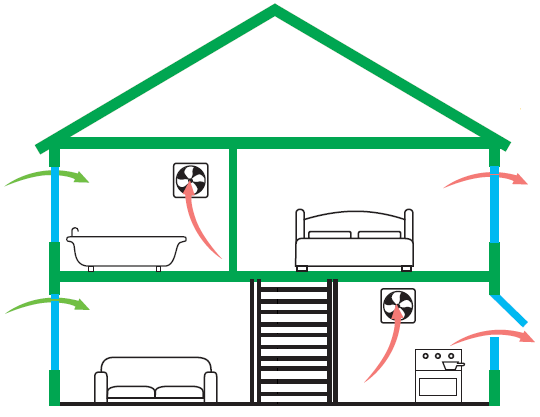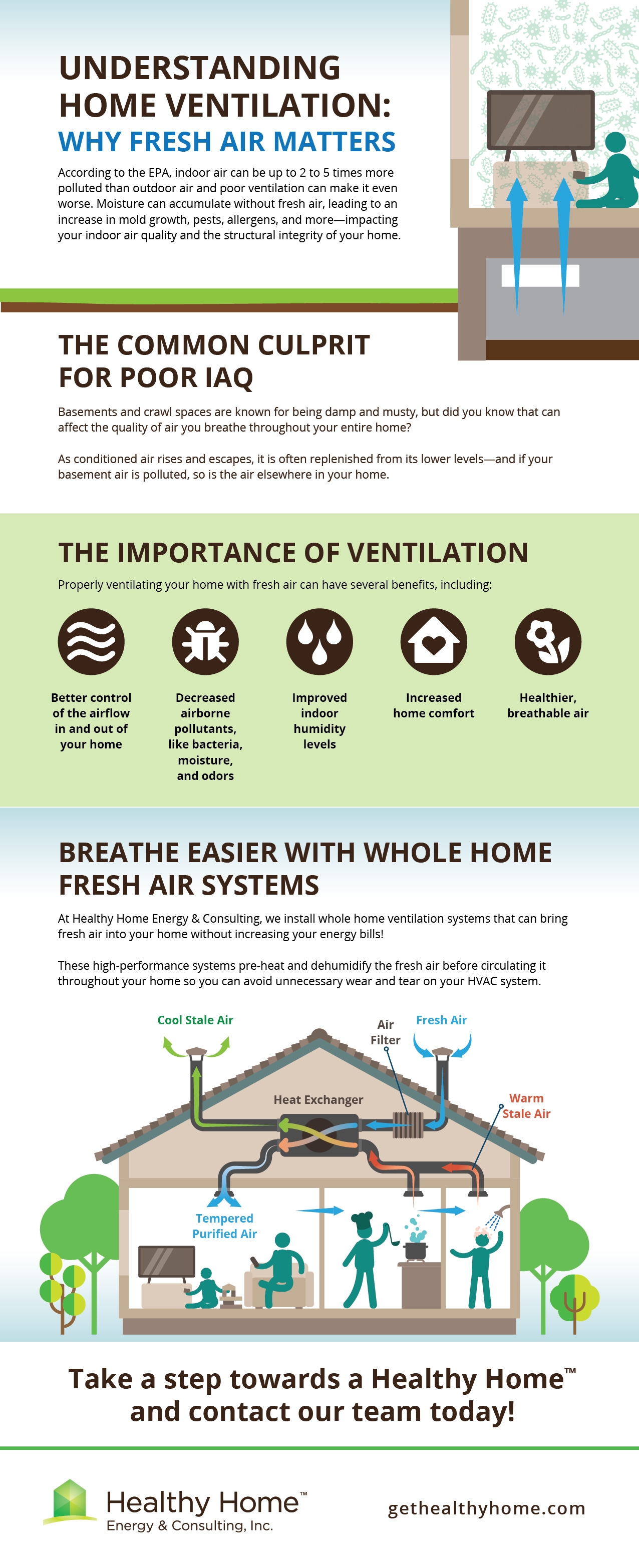Checking Out Innovative Solutions for Ideal Home Ventilation Systems
Home air flow plays an essential role in maintaining health and wellness and comfort within living spaces. With innovations in modern technology, ingenious solutions are emerging to maximize these systems. Smart air flow, energy recovery ventilators, and advanced purification are improving just how air high quality is taken care of - Home Ventilation Melbourne. Nevertheless, the integration of these innovations questions regarding their effectiveness and adaptability in diverse home environments. What implications do these advancements hold for future living requirements?
The Importance of Home Ventilation for Wellness and Comfort
Commonly ignored, home ventilation plays an important function in maintaining both health and convenience within domestic areas. Ample ventilation is important for the blood circulation of fresh air, which helps to thin down interior toxins such as volatile organic compounds, allergens, and smells. Without proper air movement, these pollutants can build up, causing respiratory system concerns and various other health issue. Furthermore, reliable ventilation contributes to controling moisture levels, preventing mold and mildew development and architectural damages. By ensuring a balanced exchange of air, residents can take pleasure in a much more pleasant interior setting, improving general health. Ample air flow can boost energy effectiveness by lowering the demand for excessive home heating or cooling, eventually resulting in reduced utility costs and an extra sustainable living space.
Smart Ventilation Equipments: Harnessing Innovation for Effectiveness
Smart air flow systems represent a significant innovation in home air management, leveraging IoT combination for improved control. These systems not only advertise power efficiency but additionally supply remote surveillance capacities, enabling individuals to maximize their interior environments seamlessly. By using innovation, house owners can attain enhanced air quality while minimizing power intake.
IoT Assimilation Benefits
Exactly how can IoT integration change traditional air flow systems right into very effective smart options? By integrating Net of Points (IoT) innovation, ventilation systems can achieve real-time tracking and control, enhancing their functional effectiveness. Sensors put throughout a home gather information on air top quality, humidity, and temperature, allowing for automated adjustments based upon present problems. This immediate responsiveness causes enhanced interior air high quality and convenience levels. On top of that, IoT-enabled systems can connect with other wise home devices, creating a cohesive ecosystem that optimizes power usage. Individuals can additionally accessibility and handle their air flow systems from another location using mobile phones, supplying comfort and boosted control. On the whole, IoT assimilation represents a substantial improvement, bringing intelligence and flexibility to standard ventilation practices.
Energy Effectiveness Features
As power performance ends up being an important emphasis in contemporary home design, progressed ventilation systems supply cutting-edge features that greatly reduce energy intake. These smart air flow systems use sensors to keep track of indoor air quality, moisture, and temperature level levels, instantly changing air movement to keep suitable problems. By utilizing energy recuperation ventilators (ERVs), they recycle and record energy from outbound air, minimizing heating and cooling down demands. Variable speed followers better enhance performance by changing their operation based upon real-time demands, stopping unnecessary power waste - Home Ventilation Melbourne. In addition, programmable timers and occupancy sensors guarantee that air flow runs only when necessary, contributing to reduced utility bills. Jointly, these attributes represent a substantial development in creating energy-efficient and lasting living settings
Remote Tracking Capabilities
What advantages do remote tracking capabilities give contemporary home ventilation systems? These capacities permit property owners to track indoor air quality and system efficiency in genuine time, enhancing general efficiency. By giving information on humidity, air, and temperature pollutants, smart air flow systems allow proactive adjustments, making certain suitable problems. In addition, remote tracking facilitates upkeep alerts, identifying prospective problems prior to they rise, consequently minimizing repair service costs and downtime. Users can access system analytics with mobile applications, permitting practical control even when far from home. This technological integration not just promotes energy effectiveness but also adds to a healthier living setting. Inevitably, remote surveillance abilities stand for a substantial development in home air flow, lining up with the expanding demand for smart home modern technologies.
Energy Recovery Ventilators: Making Best Use Of Power Cost Savings
Power recuperation ventilators (ERVs) play a vital function in enhancing home power effectiveness through effective heat exchange. By moving thermal energy between incoming and outbound air, these systems considerably lower general energy intake. This ingenious strategy not just maintains indoor air top quality however additionally adds to lower utility costs.
Effectiveness of Warm Exchange
While preserving indoor air high quality is crucial for health and comfort, the effectiveness of warm exchange in power recuperation ventilators (ERVs) plays an essential duty in optimizing power savings. The primary function of an ERV is to move warmth and wetness in between incoming and outgoing jet stream, which maximizes interior conditions while lessening energy loss. High-efficiency warmth exchangers can substantially reduce the load on heating and cooling down systems by recovering power that would certainly or else be squandered. The efficiency of these systems is commonly gauged by their core temperature level exchange prices, which can differ based upon style and materials utilized. By concentrating on advanced heat exchange technologies, home owners can improve their ventilation systems, resulting in improved power efficiency and price decreases gradually.
Minimized Power Intake
Decreasing power consumption is an essential advantage of energy healing ventilators (ERVs), as they efficiently recycle thermal power from exhausted air. By transferring heat in between outward bound and incoming air streams, ERVs decrease the demand for additional heating or cooling, bring about significant power financial savings. This visit this page process not just minimizes utility prices yet likewise minimizes the ecological influence related to greater power usage. In enhancement, ERVs keep constant indoor air high quality without compromising thermal convenience, creating a well balanced living setting. By integrating ERVs right into home ventilation systems, home owners can accomplish better energy effectiveness, enabling a sustainable strategy to indoor air administration while benefiting from reduced power expenses. Inevitably, ERVs represent an engaging service for energy-conscious customers.
Advanced Filtering Technologies for Cleaner Indoor Air
As indoor air top quality comes to be progressively identified as a vital part of health and wellness, progressed filtration innovations are arising as important tools for ensuring cleaner atmospheres. These modern technologies include high-efficiency particulate air (HEPA) filters, triggered carbon filters, and electrostatic precipitators, each made to effectively catch air-borne toxins, irritants, and volatile natural substances (VOCs) HEPA filters can trap bits as tiny as 0.3 microns, substantially reducing allergens like dust mites and animal dander. Triggered carbon filters stand out in adsorbing odors and chemical vapors, contributing to a fresher indoor environment. Furthermore, electrostatic precipitators utilize electric fees to get rid of fragments, providing an energy-efficient alternative. By integrating these sophisticated filtering systems, home owners can enhance indoor air high quality and advertise much healthier home.
The Role of Sensors in Optimizing Air Flow and Top Quality
Just how can sensing units transform the monitoring of interior air high quality? Sensors play a vital function in improving airflow and boosting interior environments. By continuously monitoring variables such as moisture, temperature, and levels of toxins, they give real-time data that informs air flow systems. This info allows automated changes to air flow, making sure sufficient flow and lessening the build-up of impurities. Additionally, progressed sensors can spot specific air high quality issues, prompting immediate actions to enhance convenience and health and wellness. The assimilation of these gadgets right into ventilation systems permits a much more efficient and receptive management technique, decreasing power usage while keeping optimal air quality. Inevitably, sensors work as an important component in developing healthier indoor spaces via exact airflow law.
Incorporating Air Flow With Smart Home Systems
While several home owners seek ease and effectiveness, integrating ventilation systems with smart home technology provides a cutting-edge remedy to managing indoor air high quality. By attaching ventilation units to wise home centers, homeowners can automate air quality tracking and control air flow based upon real-time information. These systems can reply to modifications in moisture, toxin, and temperature degrees, making sure ideal indoor conditions. Smart thermostats can work in tandem with ventilation systems to improve power performance, lowering costs while maintaining convenience. Homeowners can also remotely manage their ventilation setups with mobile applications, giving flexibility and peace of mind. Ultimately, this integration not only simplifies management however considerably enhances the general living atmosphere, making it a beneficial enhancement to modern-day homes.
Future Fads in Home Air Flow Solutions
Arising modern technologies and enhanced recognition of interior air quality are shaping the future of home ventilation solutions. One substantial fad is the combination of man-made intelligence, making it possible for systems to readjust air movement based upon real-time information and occupancy patterns. On top of that, power recuperation ventilators are getting traction, providing reliable air exchange while reducing power loss. Making use of environment-friendly materials and layouts you can check here is likewise rising, straightening with sustainability objectives. Smart sensors that monitor contaminants and humidity degrees are ending up being standard, permitting homeowners to keep suitable indoor settings. Scalable and modular systems are emerging, giving personalized choices for numerous home sizes and arrangements. Together, these improvements promise to improve convenience, efficiency, and wellness in domestic rooms
Frequently Asked Concerns
Just how Frequently Should I Tidy My Home Air Flow System?

The regularity of important site cleansing a home ventilation system varies based upon use and environment. Normally, it is advised to clean the system every three to 6 months to maintain optimal air top quality and system efficiency.
Can Poor Ventilation Reason Mold And Mildew Growth Indoors?

What Are the Signs of Inadequate Home Ventilation?
Indicators of inadequate home ventilation consist of relentless odors, increased humidity levels, condensation on home windows, visible mold and mildew growth, and a basic sensation of stuffiness. These signs usually suggest that air flow wants for maintaining a healthy indoor setting.
Just How Can I Improve Ventilation in Older Houses?
To boost air flow in older homes, one could take into consideration installing exhaust fans, utilizing natural air movement via windows, sealing gaps for much better air control, and incorporating air purifiers to improve indoor air high quality successfully.
Are DIY Ventilation Solutions Effective and Safe?

Smart ventilation, energy recovery ventilators, and progressed filtering are reshaping exactly how air high quality is taken care of. As power efficiency comes to be a crucial focus in contemporary home layout, progressed ventilation systems supply cutting-edge features that significantly minimize energy usage. By integrating ERVs into home air flow systems, home owners can achieve better power performance, making it possible for a sustainable strategy to interior air monitoring while benefiting from lower power bills. The integration of these tools right into ventilation systems allows for a much more reliable and receptive monitoring approach, minimizing energy intake while preserving perfect air top quality. While many property owners look for convenience and effectiveness, incorporating ventilation systems with smart home technology supplies an innovative solution to handling interior air quality.